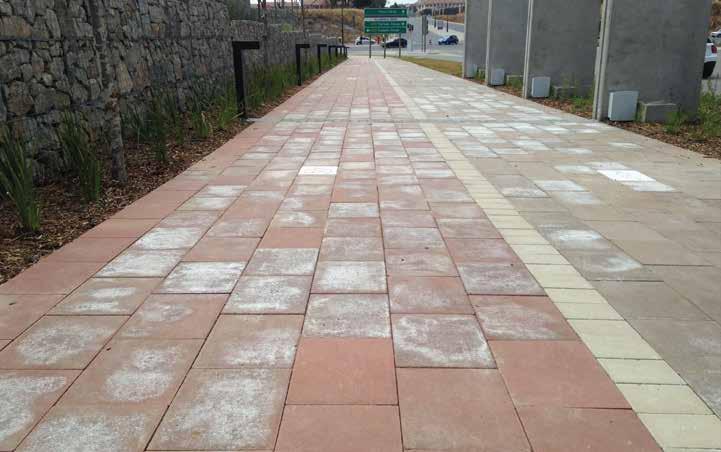
7 minute read
Design concepts
These retaining wall design concepts are based on the Bosun Robust Block and the Versoblock.
NOTE: These design concepts are GUIDELINES ONLY. Consult an engineer before building Retaining walls. For walls lower than 1,2m an engineer certificate is not required under normal conditions.
Advertisement
Normal conditions
Normal conditions can be defined as:
• The area must have good, compactable soil (no sand or clay). • If the area does not have good, compactable soil, fill material should be imported (G5 or G6 is acceptable). • Care needs to be taken when building retaining walls to prevent injury or death. • No structural or vehicular loading. • No severe surface or groundwater in the area.
Foundation:
• Excavate to a depth of ±220mm. • Compact the soil 100mm below the intended concrete foundation to 93% MOD ASSHTO. • Construct a 400mm x 120mm, 20 Mpa concrete foundation – a concrete foundation will enable easier levelling. • The first block should preferably be placed 100mm below the ground level.
Construction:
• It is recommended that the wall be constructed at a 75° angle. • After each block layer, the soil should be compacted to 93% MOD ASSHTO. Do not compact layers more than 150mm thick. • Use a vibrating roller or jumping jack tamper for compaction. Any mechanical compaction must not be closer than 300mm behind the block. Compaction 300mm and closer must be done by hand in order to prevent blocks from tilting. • Install 40/40 composite reinforcing geogrid between every second row of blocks. The geogrid should be ±800mm from the front edge of the blocks. (It is recommended that you use RockGrid® by Kaytech). • The geogrid should be laid flat, without creases.
For Bosun Versoblock installations, use a geogrid after every third block. • The most important aspect of retaining block walls is the compaction behind the blocks, together with the geogrid. The blocks merely act as the system’s “skin”.
Foundation detail

For areas with moderate surface or sub-surface water
The definition of normal conditions must be considered.
Foundation:
• Excavate to a depth of ±220mm. • Compact the soil 100mm below the intended concrete foundation to 93% MOD ASSHTO. • Construct a 400mm x 120mm, 20 Mpa concrete foundation – a concrete foundation will enable easier levelling. • The first block should preferably be placed 100mm below the ground level.
Construction:
• It is recommended that the wall be constructed at a 75° angle. • After each block layer, the soil should be compacted to 93% MOD ASSHTO. Do not compact layers more than 150mm thick. • Use a vibrating roller or jumping jack tamper for compaction. Any mechanical compaction must not be closer than 300mm behind the block. Compaction 300mm and closer must be done by hand in order to prevent blocks from tilting. • Install 40/40 composite reinforcing geogrid between every second row of blocks. The geogrid should be ±1 100mm from the front edge of the blocks. (It is recommended that you use RockGrid® by Kaytech.) • The geogrid should be laid evenly, without creases.
For Bosun Versoblock installations, use a geotextile between every third block. • The most important aspect of retaining block walls is the compaction behind the blocks. The blocks merely act as the system’s “skin”.
Sub-soil drain:
• The sub-soil drain should preferably be installed ±600mm behind the blocks in order for water to flow into the drain, as opposed to the compacted area. • Use a 75mm perforated pipe, enclosed in 19mm or 6mm stone and wrapped in 150mm x 150mm A2 non-woven filament geogrid (Bosun recommends A2 Bidim® by Kaytech). • Fines will clog the system if a geogrid is not used. • Construct outlets every 6m to dispose of water at the lowest end of the sub-soil drain.
V-drain or kerb:
• The purpose of the V-drain is to direct water away from the retaining block wall. • The V-drain or kerb should be ±1,5m behind the top edge of the wall, in order to divert water from the compacted area.

Structural drain detail

* For more comprehensive details on design concepts or walls higher than 1,2m, refer to the website: www.bosun.co.za
The load should be at least 1,7m from the edge of the wall. The definition of normal conditions must be considered.
Foundation:
• Excavate to a depth of ±220mm. • Compact the soil 100mm below the intended concrete foundation to 93% MOD ASSHTO. • Construct a 400mm x 120mm, 20 Mpa concrete foundation – a concrete foundation will enable easier levelling. • The first block should preferably be placed 100mm below the ground level.
Construction:
• It is recommended that the wall be constructed at a 75° angle. • After each block layer, the soil should be compacted to 93% MOD ASSHTO. Do not compact layers more than 150mm thick. • Use a vibrating roller or jumping jack tamper for compaction. Any mechanical compaction must not be closer than 300mm behind the block. Compaction 300mm and closer must be done by hand in order to prevent blocks from tilting. • Install 40/40 composite reinforcing geogrid between every second row of blocks. The geogrid should be ±1100mm from the front edge of the blocks. (It is recommended that you RockGrid® by Kaytech.) • The geogrid should be laid evenly, without creases.
For Bosun Versoblock installations, use a geotextile between every third block. • The most important aspect of retaining block walls is the compaction behind the blocks. The blocks merely act as the system’s
“skin”.
Sub-soil drain:
• The sub-soil drain should preferably be installed ±600mm behind the blocks in order for water to flow into the drain, as opposed to the compacted area. • Use a 75mm perforated pipe, enclosed in 19mm or 6mm stone and wrapped in 150mm x 150mm A2 non-woven filament geotextile. (It is recommended that you use RockGrid® by Kaytech.) • Fines will clog the system if a geogrid is not used. • Construct outlets every 6m to dispose of water at the lowest end of the sub-soil drain.
V-drain or kerb:
• The purpose of the V-drain is to direct water away from the retaining block wall. • The V-drain or kerb should be ±1,5m behind the top edge of the wall, in order to divert water from the compacted area.


Foundation detail
Loads should not be closer than 1m from the top edge of the retaining block wall. (Consult a civil engineer if the load is closer than 1m.) The definition of normal conditions must be considered.
Foundation:
• Excavate to a depth of ±250mm. • Compact the soil 100mm below the intended concrete foundation to 93% MOD ASSHTO. • Construct a 400mm x 150mm, 20 Mpa concrete foundation – a concrete foundation will enable easier levelling. • The first block should preferably be placed 100mm below the ground level. • Ref 193 Mesh or Y10 reinforcing can be added to the foundation, depending on the load.
Construction:
• It is recommended that the wall be constructed at a 75° angle. • After each block layer, the soil should be compacted to 93% MOD ASSHTO. Do not compact layers more than 150mm thick. • Use a vibrating roller or jumping jack tamper for compaction. Any mechanical compaction must not be closer than 300mm behind the block. Compaction 300mm and closer must be done by hand in order to prevent blocks from tilting. • Install 40/40 composite reinforcing geogrid between every second row of blocks. The geogrid should be±1 100mm from the front edge of the blocks. (It is recommended that you use RockGrid® by Kaytech.) • The last geogrid layer must be laid under the load foundation ±1 500mm from the top edge of the wall. • The geogrid should be laid evenly, without creases.
For Bosun Versoblock installations, use a geogrid between every third block. • The most important aspect of retaining block walls is the compaction behind the blocks. The blocks merely act as the system’s
“skin”.
Sub-soil drain:
• The sub-soil drain should preferably be installed ±600mm behind the blocks in order for water to flow into the drain, as opposed to the compacted area. • Use a 75mm perforated pipe, enclosed in 19mm or 6mm stone and wrapped in 150mm x 150mm A2 non-woven filament geogrid. • Fines will clog the system if a geogrid is not used. • Construct outlets every 6m to dispose of water at the lowest end of the sub-soil drain.
V-drain or kerb:
• The purpose of the V-drain is to direct water away from the retaining block wall. • The V-drain or kerb should be ±1,5m behind the top edge of the wall, in order to divert water from the compacted area.


Foundation detail
* For more comprehensive details on design concepts or walls higher than 1,2m, refer to the website: www.bosun.co.za







